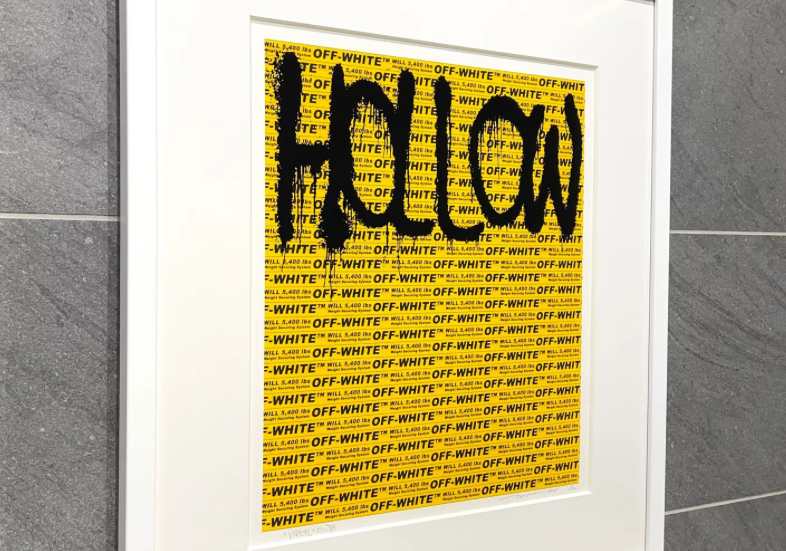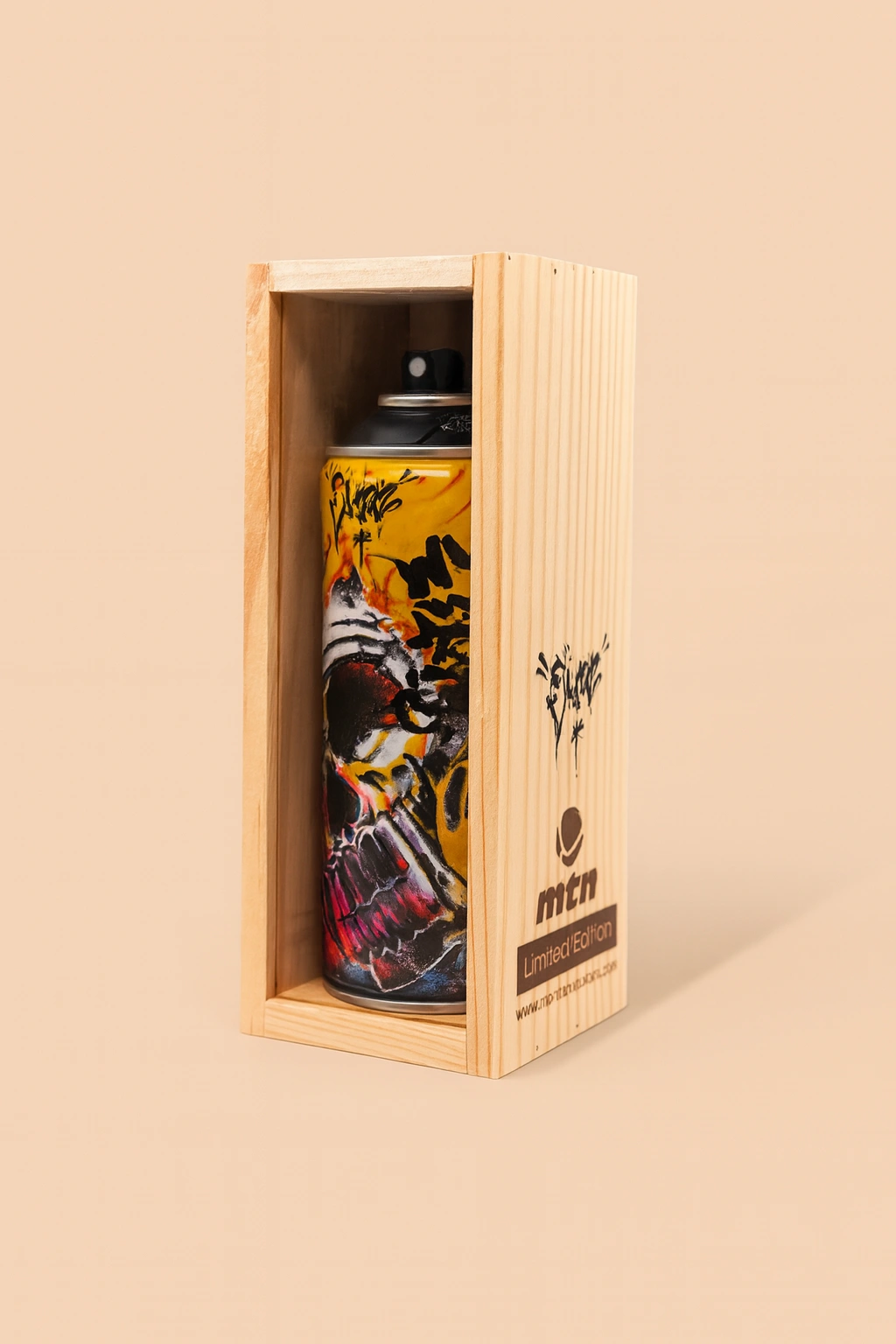In 2018, the art world witnessed a quiet but resonant moment of convergence—between East and West, luxury and streetwear, permanence and ephemera—through a transparent, spectral figure titled HOLLOWMAN. The sculpture, born from the creative alliance between Takashi Murakami and Virgil Abloh, stood as a ghostly hybrid of pop cultural density and conceptual minimalism.
Presented during their collaborative exhibition at Gagosian Beverly Hills, HOLLOWMAN was not merely a sculpture. It was a gesture of presence through absence—an acrylic echo of fashion’s invisible labor, an avatar of identity stripped bare, and a conceptual manifesto rendered in physical form. The piece was both a product and a void, interrogating the language of the body, clothing, branding, and the art object itself.
Form and Void: The Material Language of HOLLOWMAN
At first glance, HOLLOWMAN appears deceptively clean. The sculpture is crafted from clear acrylic, shaped into a simplified, almost mannequin-like silhouette—headless, faceless, gender-neutral, and armless. It echoes the generic dress forms used in fashion showrooms or photography studios. Yet, within its contours lie printed elements—Murakami’s cartoonish motifs, Abloh’s signature Helvetica typography, and references to Off-White’s graphic language.
The absence of a defined figure suggests more than aesthetic choice. It reflects a tension between object and operator—who creates, who wears, who markets, and who owns? The title, HOLLOWMAN, is a riff on both the invisible man trope and the literal garment industry slang for 3D apparel photography without models. Here, the “model” is empty. The body is optional. Yet the frame—the spectacle—remains.
This strategic transparency makes HOLLOWMAN a mirror. It’s less about what it depicts and more about what it reflects—consumer desire, authorship anxiety, and the blurred edges of cultural production.
From Streetwear to Sculpture: The Abloh-Murakami Dialogue
The partnership between Takashi Murakami and Virgil Abloh was never a simple collaboration—it was an exchange of artistic vocabularies. Murakami, a titan of Superflat aesthetics, brought his stylized flowers, bold lines, and obsessive repetition. Abloh, the polymath behind Off-White and then Louis Vuitton’s menswear, carried the language of citation, deconstruction, and recontextualization.
Together, they formed an engine of cultural feedback, remixing their respective mediums with gleeful irreverence. Their exhibitions—at Gagosian Beverly Hills and Tokyo’s Kaikai Kiki Gallery—showcased paintings, t-shirts, vitrines, and installations. But HOLLOWMAN stood apart. It was both fashion and not fashion, sculpture and anti-sculpture.
In many ways, HOLLOWMAN served as a symbolic avatar of their mutual practice. Just as Off-White reimagined clothing through quotation marks and retail theater, and just as Murakami flattened high art into commercial patternwork, HOLLOWMAN literalized the “branded absence” of the modern body in media, marketing, and fashion.
Typography as Sculpture: Virgil’s Conceptual Footprint
Central to HOLLOWMAN is Virgil Abloh’s use of language. Throughout his career, Abloh treated quotation marks not as punctuation but as material—tools to interrogate authenticity, authorship, and expectation. In HOLLOWMAN, printed phrases such as “Sculpture,” “Figure,” or “Artwork” may appear on the surface—labeling the obvious, but doing so to question its obviousness.
Abloh once described his practice as “the act of adding quotation marks to the world.” In HOLLOWMAN, those marks land not just on T-shirts or sneakers but on identity itself. The piece asks: what does it mean to be a figure without identity, but still carry brand legibility? What remains when we remove the face, the race, the body—but keep the style?
This conceptual framework—part Duchamp, part Derrida, part Donda—underlines HOLLOWMAN’s purpose. It’s not about presence. It’s about framing absence as a commercial surface.
Murakami’s Superflat Refracted
While Abloh used type and gesture, Murakami embedded visual noise into HOLLOWMAN. The translucent figure features screen-printed elements—faces, flowers, skulls—rendered in a playful but ominous palette. These aren’t simply aesthetic flourishes. They’re Murakami’s coded symbology, layered like stickers or digital textures on a game avatar.
Through Murakami’s intervention, HOLLOWMAN becomes a spiritual shell, haunted by commercial animation. His signature Superflat philosophy—flattening the hierarchy between high and low, fine art and otaku culture—translates perfectly into this form. The clear acrylic becomes a canvas, and the body becomes a conduit.
Together, Abloh and Murakami created a figure that is culturally hyper-saturated but corporeally null. It’s a soul trapped in branding.
Context of 2018: Fashion, Art, and Identity in Flux
When HOLLOWMAN debuted in 2018, Abloh had just become the artistic director of Louis Vuitton menswear—a historic appointment that made him the first Black designer to lead a major French luxury house. Murakami, already decades into his career, was still evolving his presence as a global pop figure, navigating collaborations with everyone from Kanye West to UNIQLO.
The art and fashion worlds were undergoing seismic shifts:
- Luxury brands embraced streetwear as currency
- Social media accelerated the rise of the logo as selfhood
- Identity politics entered mainstream conversations about visibility and voice
In this landscape, HOLLOWMAN served as a time capsule of post-identity aesthetics. It was genderless, raceless, and location-agnostic. It could be a model, a mannequin, a sculpture, or a retail prop. Its ambiguity made it timeless—and timely.
Critiques and Interpretations
HOLLOWMAN divided critics and viewers. Some praised it as a nuanced commentary on the absence of the marginalized in the fashion and art spheres—especially poignant considering Abloh’s trailblazing ascent. Others found it hollow in the pejorative sense—too sleek, too branded, too vague.
Yet that tension is precisely the point. The piece refuses resolution. It invites projection. It doesn’t demand emotion—it observes your gaze. In the tradition of Warhol’s Brillo boxes or Koons’ balloon animals, HOLLOWMAN transforms the commercial into the conceptual.
Legacy and Loss: After Abloh
With Virgil Abloh’s passing in 2021 at the age of 41, HOLLOWMAN takes on new resonance. What once read as theoretical now feels elegiac. The sculpture becomes an unintentional monument to absence—to a visionary who used transparency as both material and metaphor.
Murakami, who shared a close creative bond with Abloh, has continued to honor his legacy through exhibitions, NFTs, and social tributes. But HOLLOWMAN remains their most intimate co-authored object—a clear-bodied echo of what collaboration can be when it transcends categories.
In hindsight, the headless figure with no organs, no posture, and no voice becomes deeply human. It represents a voice taken too soon but echoed everywhere.
Impression
Today, HOLLOWMAN feels more relevant than ever. As conversations about AI-generated identity, avatar selfhood, and the blurring of physical/digital boundaries accelerate, the sculpture reads as both prophecy and critique.
- In the metaverse, bodies are skinned in brands.
- In social media, visibility is shaped through filters and captions.
- In luxury, the model disappears but the iconography remains.
HOLLOWMAN lives at that exact intersection—transparent, hollow, and full of meaning. A blueprint for collaboration. A critique of visibility. A love letter to the body that isn’t there.
No comments yet.








